PHOENIX — Supermarket operators have done a good job of using their stores’ perimeter departments to generate excitement and build traffic.
Supermarket operators have done a good job of using their stores’ perimeter departments to generate excitement and build traffic.
Grocery retailers have not done as well with the center of the store, though, according to a study presented at the recent Food Marketing Institute (FMI) Midwinter Executive Conference here. And that is a problem, because center store departments account for 73% of total store sales and 77% of profit.
The center store has been showing same-store sales declines in supermarkets, explained John Lewis, president and chief executive officer of Consumer North America at Nielsen Co.
Center store departments in supermarkets have become vulnerable to inroads by value players, Lewis said. Cleaning supplies once purchased as part of a consumer’s weekly trip to the grocery store may now be bought at a discount store or dollar store, for example.
"For the grocery channel alone, over a five-year period ended June 2010 this channel blurring and consumer switching trend equated to $23 billion in lost opportunity due to lost trips," Lewis explained.
In order to win back some of those trips, Lewis recommended that food retailers move away from a product-centric category management approach and instead embrace a “consumer-centric shopper management” model. Retailers need to recognize that consumers plan their shopping trips based on specific needs. Once retailers understand what consumers’ missions are when shopping, they can make sure their stores offer solutions to those specific needs.
Lewis cited the case of one leading supermarket retailer that created a store-within-a-store section devoted to pet products after recognizing that a large segment of its customer base begins each shopping trip by stocking up on pet supplies.
While the concept is still in early development stages, it has already yielded a nearly 15% increase in total pet department sales, and a 73% boost in sales of supplies and accessories. Perhaps more important, the establishment of the high-profile department shows that the retailer cares about the needs of pet owners, and makes it more likely that those customers will shop the store.
Retailers can rejuvenate their center stores by establishing other mission-driven sections, devoted to entertainment, home cleaning, alcoholic beverages, health and beauty, or housewares, Lewis said.
Many food retailers establish special displays during the holidays that address shopper missions. Around Thanksgiving, for example, a store may display stuffing, cranberry sauce, pumpkin pies, decorations, tableware and other products together in one place.
The approach need not be limited to the holidays, Lewis argued, suggesting that fully integrated meal- or event-driven sections could be built around such typical shopper needs as birthday parties. Food retailers could also establish in-aisle sections with products from around the store — everything needed for a pasta dinner, say — along with a print- and video-driven recipe center.
One food manufacturer took a similar approach, grouping its products along with complementary items into focused end-cap displays, and the result was a 30% to 70% incremental sales lift.
"While some of these ideas may not be new, there still is tremendous opportunity for all," Lewis contends in a blog post on the subject. "The store-within-a-store concept has been attempted in many cases, to mixed effect. But many of those efforts have been category focused (office supply, toy and dollar store sections, for example) rather than shopper-centric solutions.
"The magic lies in tailoring solutions to local shopper needs. Shoppers want solutions that span the entire store, and winning retailers are those who are flexible and adjust formats to cater to their needs at a mission level, not simply category by category. That means striking the right balance between perimeter and center store. At the same time, winning manufacturers will be the ones who help retailers provide these solutions with an eye on the total store, not one product. This shift from category management to shopper management is one way to drive shopper loyalty and total store growth."





